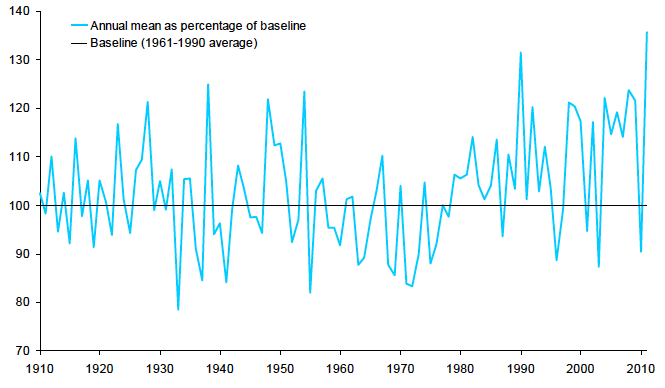Key Scottish Environment Statistics 2012
This publication aims to provide an easily accessible reference document which offers information on a wide range of environmental topics. It covers key datasets on the state of the environment in Scotland, with an emphasis on the trends over time wherever possible.
This document is part of a collection
Annual Precipitation: 1910-2011
Annual precipitation as a percentage of 1961-1990 average[1]

The average annual precipitation in the 1980s, 1990s and 2000s was higher than in previous decades, particularly the 1970s, which contained several years with below average rainfall. Annual precipitation in 2011 was 36% above the 1961-1990 baseline.
The average winter precipitation in the 1990s and 2000s was around 23% higher than the 1961-1990 baseline, compared to the 1960s which was around 9% lower. In 2011, the winter precipitation was 7% lower than the baseline, increasing from 30% below the baseline in 2010. Summer precipitation has not differed as much; average summer precipitation in the 1990s was 4% below the 1961-1990 baseline and in the 2000s 15% above the baseline. In 2011, summer precipitation was 31% higher than the baseline.[8]
Climate change will have an effect on all weather patterns in Scotland. The UK Climate Projections scenarios indicate that while the amount of annual precipitation will remain about the same, it is likely that winters will be wetter and summers will be drier. For example, projected changes[5] in the region Scotland East are a decrease in summer months[7] precipitation of 17% (-33% to 0%) and an increase in winter months[6] precipitation of 12% (1% to 25%). Precipitation changes have several implications for Scotland, affecting water resources, flood and drought risk and habitat loss.
Source: Met Office / Metadata
Contact
Email: Sandy McPhee
There is a problem
Thanks for your feedback